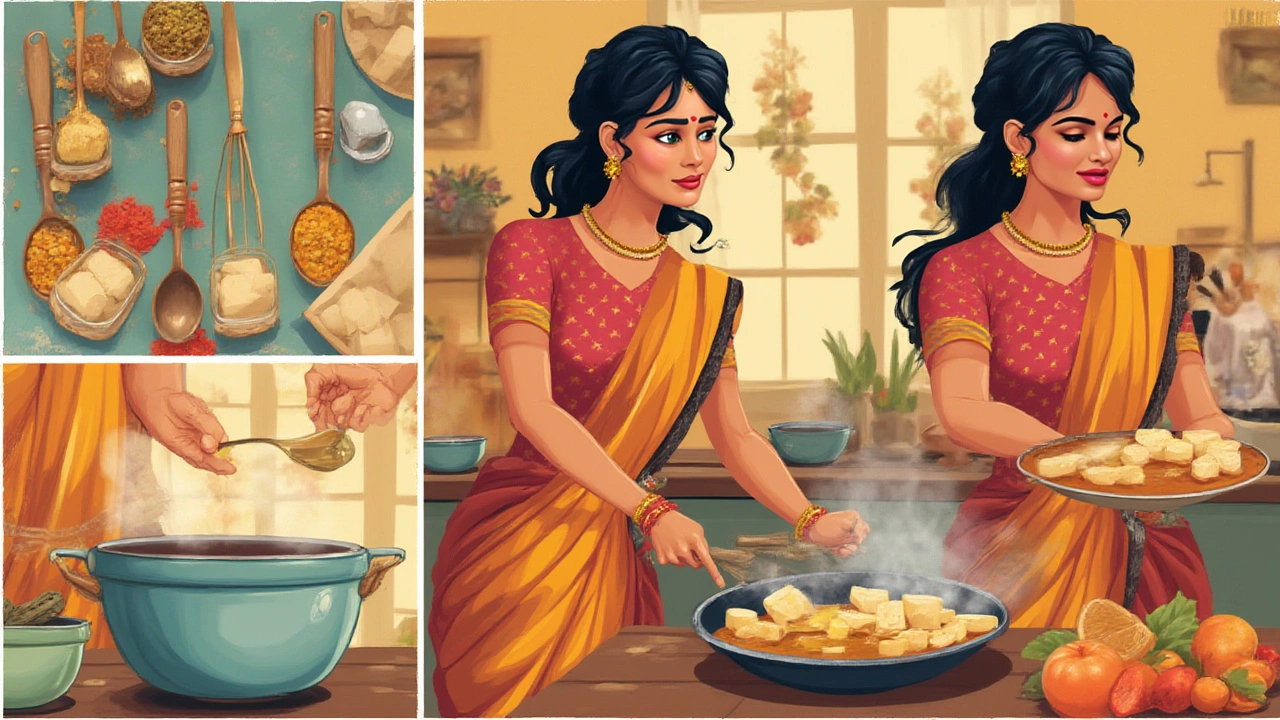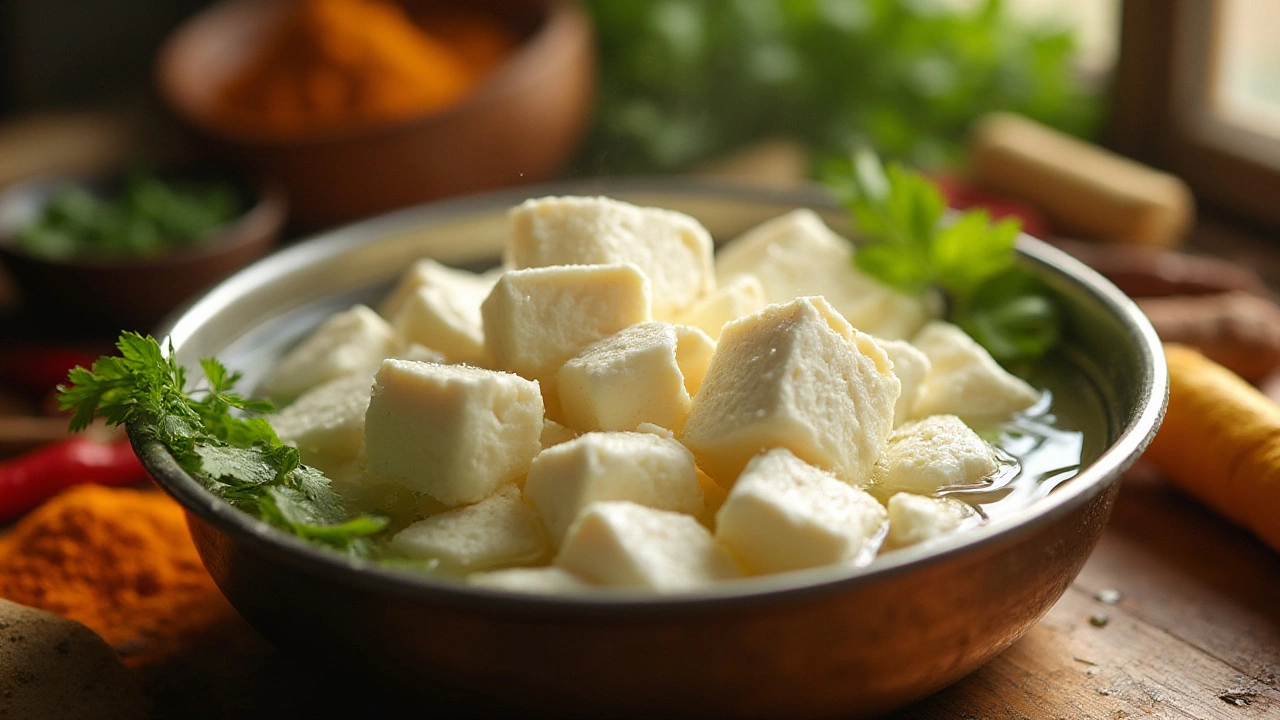If you’ve ever made a paneer dish at home and ended up with rubbery pieces, you’re not alone. There’s a common kitchen hack that many Indian home cooks swear by—soaking paneer in water before using it. It sounds almost too simple, but there’s real science (and plenty of tradition) behind it. While some might dismiss this as just another old-fashioned trick, it’s the secret sauce for those soft, juicy chunks of paneer that you get at good restaurants. You see that melt-in-the-mouth texture and wonder how chefs manage it every single time. The answer, more often than not, starts with a humble bowl of water and a block of paneer.
The Science Behind Soaking Paneer: Not Just An Old Wives’ Tale
Let’s talk about why soaking paneer actually makes a difference. Paneer, an Indian cottage cheese, is made by curdling milk with an acid like lemon juice or vinegar, then squeezing out the whey and pressing the curds. This gives it that firm texture which is perfect for grilling, frying, or dunking in thick gravies. But, here’s the catch—once paneer is cut and exposed to air, especially if it’s refrigerated or stored too long, it starts losing moisture really fast. And dry paneer not only turns rubbery but also loses its flavor-carrying power.
The process of soaking acts a bit like magic because paneer, like a sponge, can reabsorb water. When you put those chunks in a bowl of warm water—even just for 15 minutes—they plump up. The curds relax, and the paneer regains its moisture, making it soft, juicy, and able to soak up all the flavors of your curry. Several food scientists say this is all about osmosis—the movement of water molecules into the paneer’s porous structure. Think of it like reviving a dry sponge; the difference is night and day once you try it.
There’s also a little chemistry at play when you warm the water. Warm water helps open up the protein structure inside paneer, so it can absorb water faster and more evenly than cold water. For fresh or homemade paneer, soaking can be optional, but for the store-bought stuff—which often sits in vacuum-sealed packs for days or even weeks—soaking is a must if you care about flavor and texture. According to a 2023 survey by the Indian Dairy Association, 67% of home cooks reported a noticeable improvement in softness after soaking packaged paneer. That’s a stat that can’t be ignored.
Common Mistakes and How to Soak Paneer the Right Way
Not all soaking is equal, and there are some pretty common mistakes that even seasoned home cooks make. First off, don’t soak paneer straight from the fridge if you’re in a rush—that cold shock can make it toughen up rather than soften. If you want the best results, cut the paneer into your desired size—be it cubes or long strips—and place them in a bowl of warm (but not hot!) water. The water should feel pleasant to the touch, roughly the temperature you’d use for baby’s bath, somewhere between 35–40°C (that’s about 95–104°F).
A lot of people wonder, how long is enough? For most blocks, 15–20 minutes does the trick. If your paneer’s a bit older or really dry, give it 30 minutes. And if you’re working with the ultra-firm, mass-produced supermarket paneer—closer to erasers than cheese—don’t be shy about soaking it up to an hour. But more than that and paneer can start to lose structure. Another big mistake is using hot water—that can actually cook the surface, making it grainy and falling apart during cooking. Just warm, not boiling.
If you want to take it up a notch, a pinch of salt in the soaking water seasons the paneer gently, inside and out. Some chefs go further and add a splash of milk to the soaking water, which helps make the paneer extra rich and prevents it from drying during frying. A tip picked up from a home cook in Lucknow: after soaking, pat the paneer dry but don’t squeeze. Gently dab with a soft towel before adding it to your recipe. Squeezing the cubes will squish out the moisture you just worked to restore.
Here’s a simple breakdown of paneer soaking steps:
- Cut paneer into cubes or strips.
- Fill a bowl with warm water (35–40°C).
- If you like, add a pinch of salt or a splash of milk.
- Place paneer cubes in water for 15–30 minutes, depending on dryness.
- Gently remove and pat dry on a soft towel.
The difference you’ll notice in your palak paneer or paneer tikka is truly worth the extra minutes.

Do You Always Need to Soak Paneer? When to Skip or DIY
Here’s where things get interesting—it’s not always necessary to soak paneer every single time. If you made the paneer at home and just pressed it, feel free to skip soaking. Same goes if you bought fresh paneer that’s soft and moist right out of the pack. The more important reason to soak is with paneer that has been stored in the fridge for a day or more. Chilled and especially frozen paneer dries out as water molecules move from inside the cheese out towards the colder environment. This is why after defrosting, paneer often seems chalky and unappetizing.
Some recipes, like paneer bhurji (scrambled paneer), don’t need soaking since you’re crumbling the paneer and cooking it with lots of veggies, oil, and moisture. But if you’re doing something like shahi paneer, kadai paneer, or even paneer pakora, soaking makes all the difference. The softness holds up through frying and gravies, and the paneer absorbs flavors like a pro. For grilled dishes like paneer tikka, soaking first means you avoid those frustrating dry, chewy bits after grilling.
An interesting observation from Delhi restaurant chefs: even their own made-fresh-daily paneer gets a quick soak if it’s going onto the grill, because high heat dries out the surface. This tiny step keeps their tikka pieces juicy inside, even after charring. If you’re experimenting at home, try a blind taste test—soak half your paneer, leave the other half dry, and see which your family prefers. You’ll likely agree with the numbers: a 2024 poll of 1,500 North Indian home cooks found that 82% preferred the texture and flavor of soaked paneer in gravies versus unsoaked.
And if you forgot to soak your paneer but already added it to the gravy? Don’t panic! Just simmer the curry gently with the lid on. The steam will help soften the paneer, though it won’t work quite as well as the pre-soak, especially for drier, store-bought types.
More Paneer Perfection: Advanced Tips, Fun Facts, and What Not To Do
Okay, ready to geek out over paneer? Here are some neat facts and pro tips that’ll take your game from home cook to desi chef. First, did you know that India is the world’s largest producer and consumer of paneer, using nearly 70% of all the milk consumed in northern states? And yet, every region has its own slight twist on how paneer should feel and taste. In Bengal, soaking paneer (called chhena there) is less common, while in Punjab, it’s an absolute must.
If you care about nutrition, you’ll love knowing that soaking paneer doesn’t wash away much of its protein or calcium. According to data from the National Dairy Research Institute, up to 95% of paneer’s nutrients remain even after soaking. What you do lose, if you soak for way too long, is a bit of flavor and a touch of fat, but never enough to notice in a dish bursting with masala and aromatics. For those tracking food waste, soaking also helps revive older paneer, meaning fewer leftovers tossed in the bin.
Other advanced tricks? If you’re prepping for a party and want to freeze paneer, always soak after thawing, not before. Freezing creates ice crystals that push water out, so you need to add it back in afterward.
Packing school tiffins or office lunches? Soak, then fry lightly in oil or ghee before packing. The paneer will stay softer for hours. And—this is controversial—if you’re marinating paneer (for tikka or kebabs), do the soak first, pat dry, then marinate. Otherwise, the excess moisture will dilute those yummy spices in your marinade and leave you with bland results.
| Paneer Type | Soaking Needed? | Best For | Tips |
|---|---|---|---|
| Fresh Homemade | Usually not | Bhurji, curries | Soak if dry from over-pressing |
| Packaged/Store Bought | Yes, always | Grilled, fried, curries | 30 mins in warm water |
| Frozen Paneer | After defrosting | Any recipe | Soak 30–60 mins, pat dry |
| Old Paneer | Yes | Gravy dishes | Add salt to soaking water |
It might sound obsessive, but getting your soak paneer routine just right is the difference between restaurant-level feasts and basic home cooking. If soft, springy paneer is your goal, don’t skip the soak. Those few minutes make all the difference—and once you’ve tasted the result, you’ll never go back.
